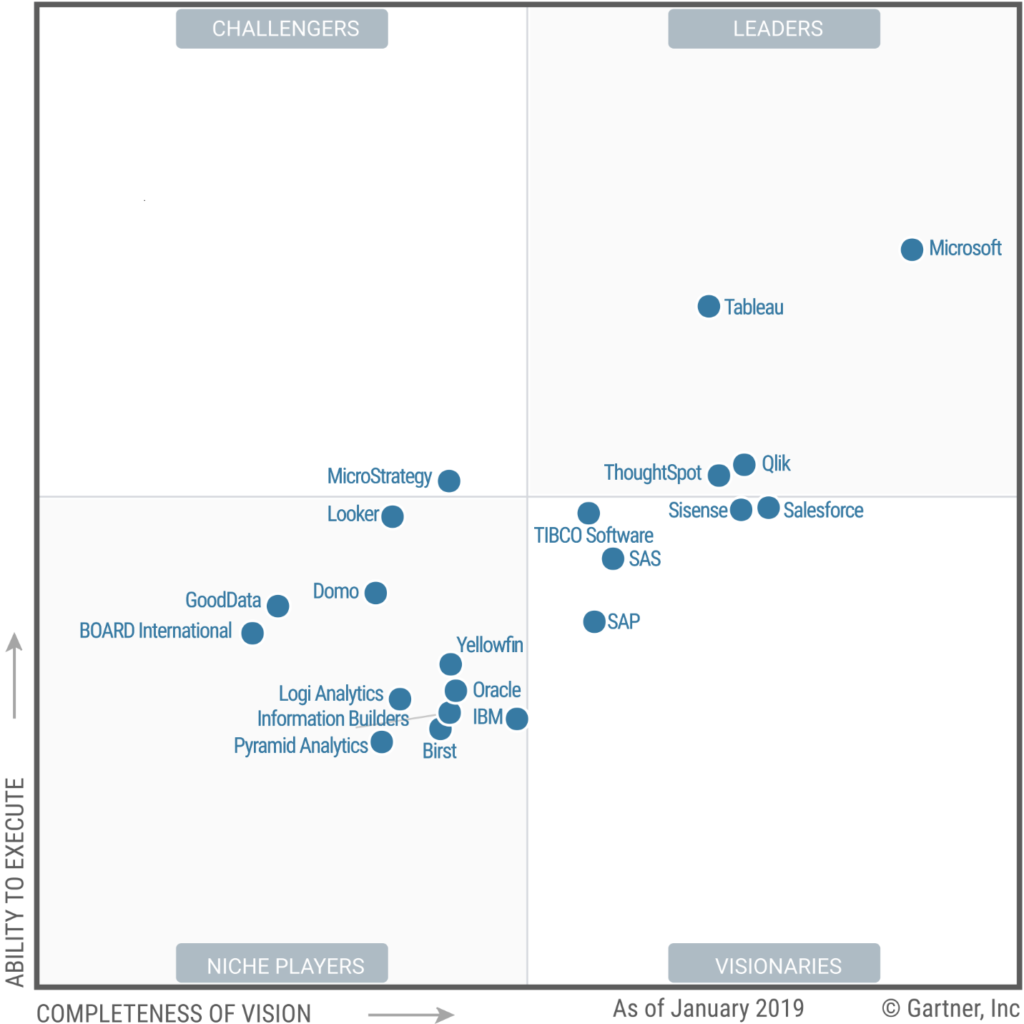
Gartner Magic Quadrant for Analytics and Business Intelligence Platforms 2019
Gartner just published its legendary Magic Quadrant for Analytics and Business Intelligence Platforms for 2019. It is always interesting to see how the SAP BI offering compares to its competitors. In previous years I’ve been critical on this report, as most of the SAP tools were completely ignored (SAP BusinessObjects BI Platform, Lumira, etc.) and SAP Analytics Cloud was really just getting started. In the 2019 edition the BOBJ stuff is still out, but that is something I can live with as SAP clearly changed its strategy to cloud.

So let’s have a look at the chart. SAP is seen as a visionaire, but with a low ability to execute. The big competitors Microsoft (PowerBI) and Tableau seem to be far ahead, both in vision and execution. The details on SAP are basically a repeat of my good, bad and the ugly write up on SAP Analytics Cloud in 2018. Some quotes from the report:
SAP is a Visionary, its position in the Magic Quadrant being influenced by product limitations and relative weakness in terms of sales and marketing strategy. SAP still does not have the broad market momentum of the Leaders in this market. Its decision to focus on one product is beginning to improve its competitiveness, however. Reference customers for SAP Analytics Cloud report a much improved view of SAP’s viability as a vendor of modern analytics and BI.
SAP Analytics Cloud’s integrated functionality for planning, analytical and predictive capabilities in a unified, single platform is a differentiator. SAP is one of only two vendors in the Magic Quadrant with such an offering.
I can only agree with this. The focus should not be on purely closing the functionality gap with the quadrant leaders, but on offering a more integrated, broader solution.
SAP Analytics Hub is intended to bridge cloud and on-premises deployments, providing a single front end for SAP and partner-originated analytic offerings. This vision is resonating — reference customers for SAP Analytics Cloud showed a bigger improvement in their view of their vendor’s viability than any other group of reference customers surveyed for this Magic Quadrant.
Yes, the Hub is a strong and smart solution with an obvious purpose. But, it could have been much better than what is now being offered and I haven’t seen much progress in the past year.
Prepackaged analytic content: SAP offers a library of prebuilt content available online for SAP Analytics Cloud customers.
Gartner sees this as a strength, but this is not going to win the war. Reporting business content is nice to get some inspiration and ideas, but is not an out-of-the-box solution.
Functional limitations: SAP Analytics Cloud still lags behind in a number of areas, particularly scalability and model complexity. In addition, the SAP-source-dominated data source connectivity and ingestion capability, and the ability to embed analytic content, are relatively weak.
Performance is the primary limitation with regard to wider deployment of SAP Analytics Cloud, according to its reference customers. They put SAP’s product support — specifically its time to respond to and resolve issues — in the bottom third of vendors in this Magic Quadrant.
Ouch. Still a lot of work to do here.
Cloud-only: Most organizations now view cloud-based software as part of data and analytic deployments, but a significant minority still do not. For that minority, SAP Analytics Cloud isn’t a good fit, although it can connect directly to on-premises SAP resources for live data and to some non-SAP data sources for data ingestion.
Gartner mentions this as a weakness, I don’t think it is. The live connectivity architecture is a smart solution where the data doesn’t have to leave the company network and doesn’t go “into the cloud”, which would be the biggest point of resistance for these customers.
Let’s now have a look at some comments on Tableau and Microsoft PowerBI from the report.
Tableau: Easy visual exploration and data manipulation: Tableau enables users to rapidly ingest data from a broad range of data sources, blend them, and visualize results using best practices in visual perception. Data can be manipulated while visualizing — such as when creating groups, bins and new hierarchies — all with a high degree of ease of use.
This is indeed what I’ve seen and heard from Tableau users. It’s very easy to use and extremely flexible and feature-rich.
Tableau: Customers as fans: Customers have a fanlike attitude toward Tableau, as evidenced by the record 17,000 users that attended its 2018 annual user conference. Reference customers placed Tableau in the top third of Magic Quadrant vendors for customer experience, and gave it high scores for achievement of business benefits. Tableau sets the industry standard for user enablement with Meetup groups, roadshows, online tutorials and availability of skills in the market.
Here SAP clearly missed the boat. This Tableau community reminds me a bit of what the BusinessObjects and especially the Xcelsius community was 10 years ago. People were sharing their extremely creative ideas on how to get everything out of the tools. The broken SAP Community doesn’t help in this as well
Microsoft PowerBI: Low-priced incumbent with positive sales experience
Giving away PowerBI for (almost) free and bundling it with the WindowsOS is a strategy that Microsoft is known for, and clearly seems to work for PowerBI (which is a great, great name for a BI tool by the way! Much better than the generic SAP Analytics Cloud).
Microsoft PowerBI: Ease of use for complex types of analysis: Reference customers continue to recognize Microsoft for its ease of use — they gave it top-third ratings across all aspects of ease of use.Microsoft’s “first five-minute experience”(it aims to have users register for a trial and be “wowed” within five minutes) and a robust user community contribute to this result.
I’ve seen lots of first time BI users start out with these trial (or university) licenses in Tableau or PowerBI and get hooked to the tool. SAP Analytics Cloud has a free 30-day trial option, but needs to push this more.
So in conclusion, the report gives a good overview of where SAP Analytics Cloud stands in relation to its competitors, but I don’t read many new or unexpected insights. Important is that the unified platform solution is clearly recognized as a unique offering, as this could be the differentiator for SAP Analytics Cloud in the market.

